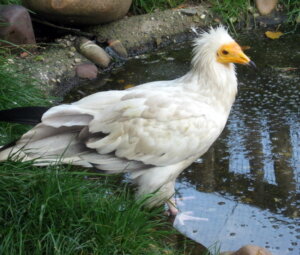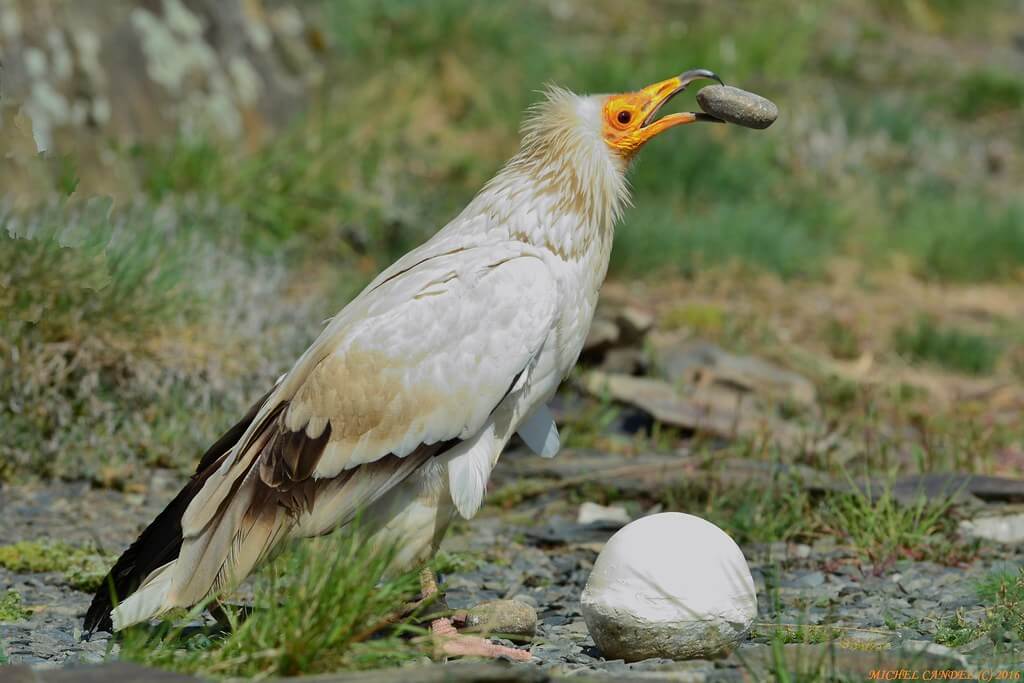Egyptian Vulture: Habitat, Characteristics and Curiosities


Written and verified by the biologist Cesar Paul Gonzalez Gonzalez
The Egyptian Vulture is a peculiar-looking bird endemic to Africa, Europe, and India. It used to be a fairly common species in Spain, but nowadays its population has suffered many casualties due to the use of poison in animals.
The scientific name of this species is Neophron percnopterus. It belongs to the family Accipitridae, which contains most diurnal birds of prey such as eagles, hawks, and vultures. Read on to find out more about the Egyptian vulture.
Habitat and distribution
Although the natural distribution of the Egyptian vulture is restricted to southern Europe, Asia, and North Africa, there are some isolated populations in the Canary Islands and Cape Verde. It frequents mountainous and rocky areas with high cliffs. However, they can adapt to other different areas provided that their habitat is clear and there are no human populations.

Egyptian vulture characteristics
Contrary to what we observe with other birds of prey, the Egyptian vulture is a medium-sized specimen with few predatory traits. On average, it’s about 60 centimeters (around 24 inches) long and has a wingspan of just over 160 centimeters (63 inches). It has a yellow face that makes it look as if it were wearing a mask, in addition to a white plumage with some cream, brown, and black regions.
Another great difference between the Egyptian vulture and other birds of prey is its peculiar curved beak, which ends in a point and doesn’t have the function of tearing the flesh of its prey. In fact, vultures use their beaks to select their food or capture small insects.
Like other vultures, the diet of the Egyptian vulture is based on the consumption of decomposing carcasses (carrion). However, because it’s much smaller than other birds of its kind, it’s usually the last to approach the carcasses. Therefore, it carefully selects the most nutritious parts of its prey and continues its search in order to make its feeding more efficient.
Although it’s true that most of the time it’s a scavenger, this bird is also capable of hunting and killing some small wounded or sick animals. The only problem with this is that the Egyptian vulture is unable to tear apart the carcass, so it needs other scavenging birds to finish the job.
In some cases, the Egyptian vulture chooses to forage in garbage dumps and landfills to facilitate its feeding. It’s even capable of ingesting the excrement of domestic livestock. In this way, it takes advantage of decomposing organic matter without having to wait for other birds to help it, which saves it work and gives it more options for its diet.
Behavior
Because the Egyptian vulture needs other birds of prey in its environment to feed well, it tends to live close to similar species. Therefore, it’s possible to observe them living together in groups or alone, depending on the availability of resources in their habitat.
Some specimens exhibit different warning flights to protect their nests from the presence of predators. However, this is only done during the breeding season, as in other seasons they’re more tolerant to the presence of different animal species.

Reproduction
The Egyptian vulture is a monogamous bird that chooses a single mate for its entire life. It breeds once a year and the mating season varies according to the region in which it lives, although it usually takes place between March and May.
When the birds reach sexual maturity, the male begins to court the female by means of flight demonstrations with several swooping descents. This serves to attract the attention of his potential mate and demonstrate his physical abilities. If the female accepts, she will proceed to grab hold of the male’s talons during her descent and they will fly together for a few moments to confirm their relationship.
Egyptian vultures commonly nest on cliffs and rocky valleys, which protects them from some of the predators common in their habitat. In addition, they use the remains of animal hair, branches, and bones to build their nest. Thanks to this, the young will stay quite warm and protected, despite being at high altitudes.
Females lay an average of two eggs per season and incubation lasts about 45 days. Once the chicks hatch, the mother will take care of them while the male will provide food and guard the nearby territory. These young will leave the nest at 3 months of age and become independent at 4 months.
Problems with the Egyptian vulture population
There are thought to be between 10,000 and 100,000 Egyptian vultures in existence today, although their population seems to be steadily declining. The main cause of this problem is indiscriminate hunting and the use of illegal pesticides, which has caused it to become a rare species in several areas of Spain and Portugal.
The International Union for Conservation of Nature has classified the Egyptian Vulture as an endangered species. As a result, several countries have taken action to try to learn about and remedy the risk faced by this bird. It’s still too early to know if these measures will work, but, without them, it’s clear that this beautiful bird would be destined for extinction.
The Egyptian Vulture is a peculiar-looking bird endemic to Africa, Europe, and India. It used to be a fairly common species in Spain, but nowadays its population has suffered many casualties due to the use of poison in animals.
The scientific name of this species is Neophron percnopterus. It belongs to the family Accipitridae, which contains most diurnal birds of prey such as eagles, hawks, and vultures. Read on to find out more about the Egyptian vulture.
Habitat and distribution
Although the natural distribution of the Egyptian vulture is restricted to southern Europe, Asia, and North Africa, there are some isolated populations in the Canary Islands and Cape Verde. It frequents mountainous and rocky areas with high cliffs. However, they can adapt to other different areas provided that their habitat is clear and there are no human populations.

Egyptian vulture characteristics
Contrary to what we observe with other birds of prey, the Egyptian vulture is a medium-sized specimen with few predatory traits. On average, it’s about 60 centimeters (around 24 inches) long and has a wingspan of just over 160 centimeters (63 inches). It has a yellow face that makes it look as if it were wearing a mask, in addition to a white plumage with some cream, brown, and black regions.
Another great difference between the Egyptian vulture and other birds of prey is its peculiar curved beak, which ends in a point and doesn’t have the function of tearing the flesh of its prey. In fact, vultures use their beaks to select their food or capture small insects.
Like other vultures, the diet of the Egyptian vulture is based on the consumption of decomposing carcasses (carrion). However, because it’s much smaller than other birds of its kind, it’s usually the last to approach the carcasses. Therefore, it carefully selects the most nutritious parts of its prey and continues its search in order to make its feeding more efficient.
Although it’s true that most of the time it’s a scavenger, this bird is also capable of hunting and killing some small wounded or sick animals. The only problem with this is that the Egyptian vulture is unable to tear apart the carcass, so it needs other scavenging birds to finish the job.
In some cases, the Egyptian vulture chooses to forage in garbage dumps and landfills to facilitate its feeding. It’s even capable of ingesting the excrement of domestic livestock. In this way, it takes advantage of decomposing organic matter without having to wait for other birds to help it, which saves it work and gives it more options for its diet.
Behavior
Because the Egyptian vulture needs other birds of prey in its environment to feed well, it tends to live close to similar species. Therefore, it’s possible to observe them living together in groups or alone, depending on the availability of resources in their habitat.
Some specimens exhibit different warning flights to protect their nests from the presence of predators. However, this is only done during the breeding season, as in other seasons they’re more tolerant to the presence of different animal species.

Reproduction
The Egyptian vulture is a monogamous bird that chooses a single mate for its entire life. It breeds once a year and the mating season varies according to the region in which it lives, although it usually takes place between March and May.
When the birds reach sexual maturity, the male begins to court the female by means of flight demonstrations with several swooping descents. This serves to attract the attention of his potential mate and demonstrate his physical abilities. If the female accepts, she will proceed to grab hold of the male’s talons during her descent and they will fly together for a few moments to confirm their relationship.
Egyptian vultures commonly nest on cliffs and rocky valleys, which protects them from some of the predators common in their habitat. In addition, they use the remains of animal hair, branches, and bones to build their nest. Thanks to this, the young will stay quite warm and protected, despite being at high altitudes.
Females lay an average of two eggs per season and incubation lasts about 45 days. Once the chicks hatch, the mother will take care of them while the male will provide food and guard the nearby territory. These young will leave the nest at 3 months of age and become independent at 4 months.
Problems with the Egyptian vulture population
There are thought to be between 10,000 and 100,000 Egyptian vultures in existence today, although their population seems to be steadily declining. The main cause of this problem is indiscriminate hunting and the use of illegal pesticides, which has caused it to become a rare species in several areas of Spain and Portugal.
The International Union for Conservation of Nature has classified the Egyptian Vulture as an endangered species. As a result, several countries have taken action to try to learn about and remedy the risk faced by this bird. It’s still too early to know if these measures will work, but, without them, it’s clear that this beautiful bird would be destined for extinction.
All cited sources were thoroughly reviewed by our team to ensure their quality, reliability, currency, and validity. The bibliography of this article was considered reliable and of academic or scientific accuracy.
- Rosenblatt, E. (2007). “Neophron percnopterus” (On-line), Animal Diversity Web. Recuperado el 27 de septiembre de 2022, disponible en: https://animaldiversity.org/accounts/Neophron_percnopterus/
- BirdLife International. (2021). Neophron percnopterus. The IUCN Red List of Threatened Species 2021: e.T22695180A205187871. https://dx.doi.org/10.2305/IUCN.UK.2021-3.RLTS.T22695180A205187871.en.
- Donázar, J. A., Ceballos, O., & Tella, J. L. (1996). Communal roosts of Egyptian vultures (Neophron percnopterus): dynamics and implications for the species conservation. Biology and conservation of Mediterranean raptors. Madrid: SEO BirdLife, 190-201.
- Donazar, J. A., Ceballos, O., & Tella, J. L. (1994). Copulation behaviour in the Egyptian Vulture Neophron percnopterus. Bird study, 41(1), 37-41.
This text is provided for informational purposes only and does not replace consultation with a professional. If in doubt, consult your specialist.








